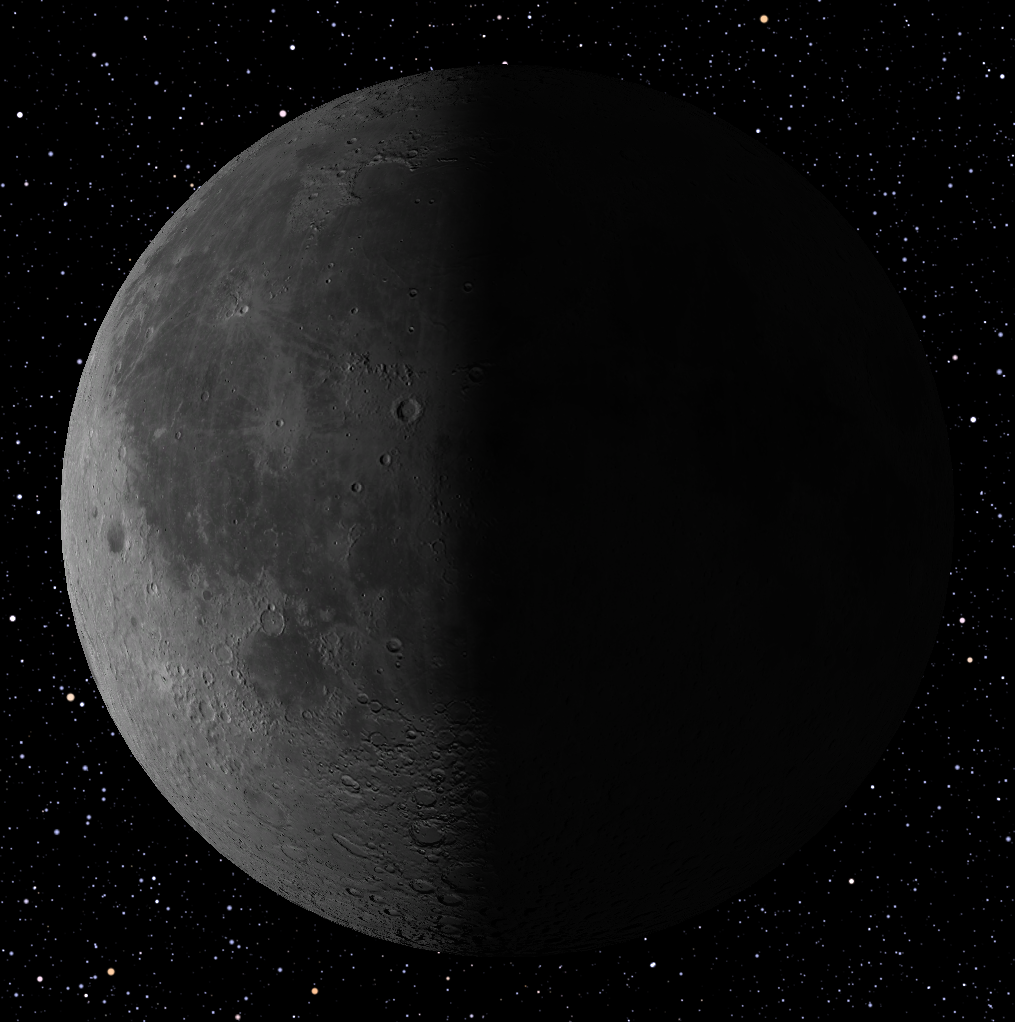The Moon's 'Blue' Last Quarter Phase Explained

As the moon moves around Earth in its monthly orbit, there are four points at which it is in exact geometry with the sun and Earth: new moon, first quarter, full moon, and last quarter.
These are the four points at which the Earth, moon and sun are in a straight line, or the sun and moon form a 90-degree angle as seen from Earth.
At new moon, the moon is between Earth and sun, so we are trying to see the moon's dark side in front of the brilliant sun. We can never see the moon at new moon because of the bright sunlight, except on the rare instances when the moon is directly in front of the sun and we get a solar eclipse. Because of the tilt of the moon's orbit, most of the time it passes either above or below the sun, but still close enough that it is lost in the sun's glare. [Moon Photography Tips from Astrophotographers: A Visual Guide]
At full moon, Earth is between sun and moon, so the moon is exactly opposite the sun in Earth's sky. The moon rises just as the sun sets, and sets just as the sun rises. The side of the moon we see is fully illuminated, except on the rare occasions when the shadow of Earth falls on the moon: a lunar eclipse. Once again, the tilt ofthe moon's orbit makes it usually pass above or below the Earth's shadow.
The quarter moon phases, first and last, fall exactly in between new and full moon, when the moon is a quarter or three quarters of the way around Earth. These are the best times to observe the surface of the moon, because the sun is just rising or setting along the terminator, the dividing line between bright and dark sides of the moon. The moon's surface features are shown in stark relief by the rising or setting sun.
The average skywatcher is much more familiar with the appearance of the first quarter moon than the last quarter moon. That's because first quarter always occurs when the moon is in the evening sky, when most of us do our observing. The last quarter moon is much more rarely seen because it is mainly visible in the wee hours of the morning.
Because the moon takes 29 and a half days to go through its cycle of phases, sometimes we can get the same phase twice in a calendar month, usually 30 or 31 days. This is most noticeable with the full moon, and some people have named the second full moon in a month a "blue moon."
Breaking space news, the latest updates on rocket launches, skywatching events and more!
Last month, in February with only 29 days, many parts of the world missed out on having any last quarter moon. This month we make up for it by having two last quarter moons. The first was on Tuesday, March 1, at 6:11 p.m. EST. The second occurred on Thursday, March 31, at 11:17 a.m. EDT.
If a second full moon in a month is called a "blue moon," perhaps a second last quarter moon in a month could be called a "blue last quarter." [Amazing Blue Moon Photos by Lunar Fans]
Like any "blue moon" this "blue last quarter" won't look any different from a regular last quarter, and certainly won't be blue in color. It is simply an accident of our calendar.
The best time to observe a last quarter moon is around sunrise, before the sky becomes fully light. Look for the moon close low in the southern sky at sunrise (in the northern hemisphere).
If you look at the last quarter moon with a telescope, you will be surprised at how different some of the familiar features look with the sunlight coming from the opposite direction. Most striking is the famous scarp known as the Straight Wall, a bit south of the center of the moon's disk. At first quarter it appears as a dark line, with the sun rising to its east. At last quarter, its westward facing face is fully lit by the setting sun, and appears as a bright white line.
Try capturing this rare event in a photograph, something seen only "once in a blue last quarter moon." Even a cell-phone camera is capable of making good pictures of the moon through a telescope.
Editor's note: If you capture an amazing view of the moon, or any other night sky view, and you'd like to share it with Space.com and our news partners for a story or gallery, you can send images and comments to managing editor Tariq Malik at spacephotos@space.com.
This article was provided to SPACE.com by Simulation Curriculum, the leader in space science curriculum solutions and the makers of Starry Night and SkySafari. Follow Starry Night on Twitter @StarryNightEdu. Follow us @Spacedotcom, Facebook and Google+. Original article on Space.com.

Geoff Gaherty was Space.com's Night Sky columnist and in partnership with Starry Night software and a dedicated amateur astronomer who sought to share the wonders of the night sky with the world. Based in Canada, Geoff studied mathematics and physics at McGill University and earned a Ph.D. in anthropology from the University of Toronto, all while pursuing a passion for the night sky and serving as an astronomy communicator. He credited a partial solar eclipse observed in 1946 (at age 5) and his 1957 sighting of the Comet Arend-Roland as a teenager for sparking his interest in amateur astronomy. In 2008, Geoff won the Chant Medal from the Royal Astronomical Society of Canada, an award given to a Canadian amateur astronomer in recognition of their lifetime achievements. Sadly, Geoff passed away July 7, 2016 due to complications from a kidney transplant, but his legacy continues at Starry Night.

